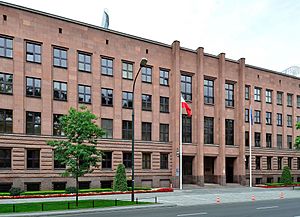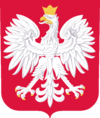Ministry of Foreign Affairs (Poland) facts for kids
| Ministerstwo Spraw Zagranicznych | |

Ministerial logotype
|
|
 The current seat of the Ministry of Foreign Affairs, located on Szucha Avenue |
|
| Agency overview | |
|---|---|
| Headquarters | Al. J. Ch. Szucha 23, Warsaw |
| Agency executive |
|
| Parent agency | Council of Ministers |
| Website | https://www.gov.pl/diplomacy |
The Ministry of Foreign Affairs (in Polish: Ministerstwo Spraw Zagranicznych, often called MSZ) is a very important part of the Polish government. Its main job is to handle Poland's relationships with other countries around the world. It also helps Poland work with big international groups like the European Union and the United Nations. The person in charge of this ministry is called the Minister of Foreign Affairs, and they are a key member of the Polish government.
Contents
What the Ministry of Foreign Affairs Does
The Ministry of Foreign Affairs works to keep Poland on good terms with other nations. It acts as Poland's voice and representative on the global stage.
Representing Poland Abroad
All of Poland's embassies and consulates in other countries report to this Ministry. The people who work there, like ambassadors, are part of the Ministry's team. Even though the President of Poland officially appoints ambassadors, the Minister of Foreign Affairs suggests who should get these important jobs.
An Important Government Role
This ministry is seen as one of the most important in Poland. The Minister of Foreign Affairs is usually a very experienced politician. They need to be smart and good at dealing with people from different cultures.
History of the Ministry
The Ministry of Foreign Affairs was first created a long time ago, when Poland was becoming independent again after World War I.
Early Beginnings
It started in 1917, but it really began its work after Poland gained full independence. For many years, until 1939, the Ministry was located in a beautiful building called the Brühl Palace in Warsaw.
During World War II
When World War II started in 1939, the Polish government had to leave the country. The Ministry of Foreign Affairs moved with them, first to France, then to London. This was known as the Polish government in exile. They continued to represent Poland from abroad during the war.
After 1945
After 1945, a new government was formed in Warsaw. Most countries then recognized this new government. The Ministry of Foreign Affairs was restarted in Poland. Since 1989, the Ministry has been in a group of buildings on Aleje Szucha in central Warsaw. This is close to where the Prime Minister's office is.
How the Ministry is Organized
The Ministry has different departments that focus on specific parts of its work.
Regional Affairs Departments
These departments keep an eye on what's happening in different countries around the world. They help Poland build relationships with these countries. They also make sure Poland works well with international groups in those regions. Each department is responsible for Polish embassies and consulates in its area.
Here are some of the departments:
- Asia-Pacific Department (for countries in Asia and the Pacific)
- Department of Africa and the Middle East
- Department of the Americas (for North and South America)
- Eastern Department (for countries to Poland's east)
- European Policy Department (for countries in Europe)
- Department of Consular Affairs (helps Polish citizens abroad)
- Department of Public and Cultural Diplomacy (shares Polish culture)
- Department of United Nations and Human Rights (works with the UN)
- Security Policy Department (deals with safety and defense)
Current Minister of Foreign Affairs
| Minister of Foreign Affairs | |
|---|---|
 |
|
| Formation | 26 November 1917 |
| First holder | Leon Wasilewski |
| Website | www.msz.gov.pl |
The current Minister of Foreign Affairs is Radosław Sikorski. He started his role on December 13, 2023. Many different people have held this important job throughout Poland's history.
Images for kids
-
During the inter-war period the Ministry of Foreign Affairs was housed in the rococo Brühl Palace in central Warsaw



